This is the second article in a three-part series on “Electrifying Everything” in Canada.
In the first installment, I looked at the climate urgency to “electrify everything” and how Canada has fared so far.
Summary: Canada’s fossil fuel use has grown faster than overall energy use. That has increased Canada’s dependence on burning fossil fuels from 70 percent in 2005 to 74 percent now. By contrast, Canadian electricity use has dropped to just 20 percent of our energy use. Instead of “electrifying everything”, as is required to stop the climate crisis, we are busy de-electrifying ourselves.
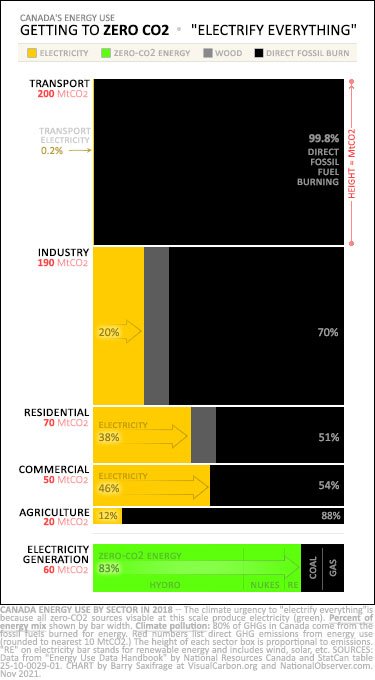
That’s according to data from National Resource Canada Energy Use Data Manual, which covers the years 2000 to 2018.
I used that same data to create this “Electrify All” overview box. It shows the mix of energy and emissions for each sector of the Canadian economy.
In my first post, I briefly walked through this sector-by-sector graph and provided an overview of our electricity generation.
In this second article, I’ll take a closer look at the top sector of the chart: transportation.
Transportation is at the top because it emits the highest amount of climate pollution – around 200 million tons of CO2 per year (MtCO2). Climate pollution is the reason we need to make this energy transition. And the graph emphasizes this by setting the height of each sector’s box to match its emissions from energy use.
Not only is the transportation sector our largest emitter, it is also the least electrified in Canada, at a fraction of one percent.
Dig deeper
These government data divide transportation into three subsectors: people in motion, cargo in motion, and all-terrain vehicles (logging machinery, tractors, combines, and excavators used in mining).
Analysis: Columnist @bsaxifrage takes us on a graphically packed tour of where we are in our climate-required energy transition when it comes to transportation.
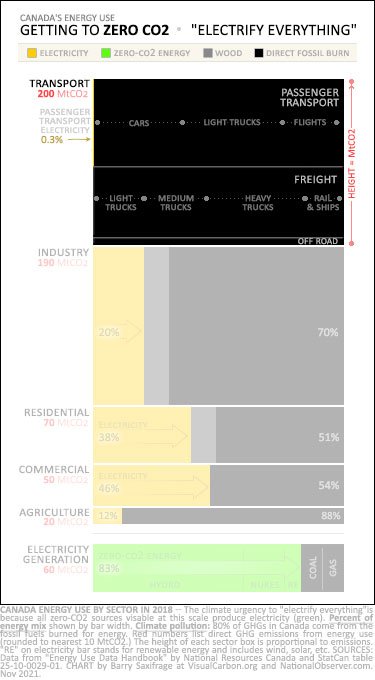
Cargo and ATVs are responsible for a little less than half of the energy and emissions of our transportation. As the graph shows, cargo trucks of various sizes dominate. Electrification is so insignificant that the manual doesn’t even have an electricity category for them.
Passenger transport consumes even more energy and emits even more climate pollution. The use of electricity is trivial to less than one percent. The corresponding orange bar on the chart is barely visible.
Despite all the political and media buzz about electric vehicles (EVs), as we’ll see next, Canadians don’t buy a lot. Instead, more than 97 percent of the new passenger cars Canadians bought last year were fossil burners.
Transportation energy trends
As my “Electrify Everything” chart makes painfully clear, more than 99 percent of Canada’s transportation remains dependent on the burning of climate-destabilizing fossil fuels. And that’s not even the most daunting part. Worse still for our hopes for a secure future, fossil burning continues to spiral out of control across the transportation sector.
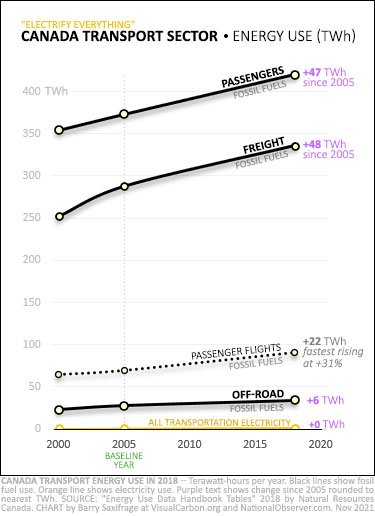
As the purple text on my graph shows, fossil burning for passenger, cargo and ATVs increased by 100 TWh combined, since 2005 alone. That is Canada’s baseline year for our Paris Agreement climate goals.
In contrast, electricity increased only 0.24 TWh. That’s the orange line that lies flat on the floor at the bottom.
The climate math for our transportation is brutal: Canadians have ignited fossil burning 420 times more than electricity since 2005.
We are stomping on the fossil pedal hundreds of times stronger than the clean energy pedal. Our kids are strapped in the back seat and the adults are speeding everyone up. right next to the climatic cliff.
Almost all of the fossil burned for transportation is some form of petroleum: gasoline, diesel, jet fuel, and ship fuel. Honestly, I have no idea why the oil boosters in Alberta are so grumpy these days. Not only is fossil oil gaining big in Canada, it is crushing our climate-safe energy hundreds of times. Even the phrase “left in the dust” would be a huge overstatement because Canadians’ burning of fossil oil is so far advanced and far faster than its dust will have settled centuries before our climate-safe electricity advances.
We are digging a huge climate hole for ourselves.
How Government Policy Drives Fossil Burning
Most of all this burning of fossil fuels comes from a single source: gasoline and diesel that are sold at the pump.
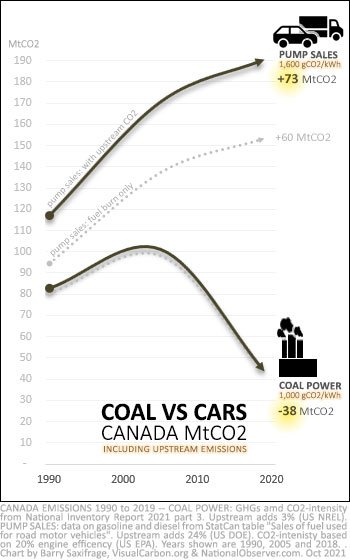
As my graph below shows, climate pollution caused by Canadian pump sales increased by 73 MtCO2 since 1990.
That more than wiped out all the progress Canadians made in shutting down coal power.
Why Are Pump Sales Soaring In Canada?
One main reason is that Canadian policy keeps our gasoline taxes well below the average paid by our peers in other OECD and G7 nations. For example, Canadians pay $ 400 less than the British, Germans, French, or Norwegians for dumping every ton of CO2 through our tailpipes.
The government of Canada likes to sell itself as a leader in carbon pricing. But when it comes to our largest and most out-of-control source of emissions, the reality is exactly the opposite.
Making it much cheaper to pollute the climate in Canada creates incentives to pollute the climate more. Which is exactly what is happening.
Adds. The average car in Canada emits 66 tons of CO2 from its tailpipe over its useful life. At $ 400 less per ton, Canadians end up paying $ 26,000 less for climate pollution per vehicle than our peers in Britain, Germany, Norway or France.
With government policy like that, it should come as no surprise when the International Energy Agency reports that Canadians buy the new cars and trucks that pollute the world’s climate the most.
And by making it dramatically cheaper to pollute the climate with gasoline vehicles, it also dramatically reduces the incentive for Canadians to choose an electrically powered vehicle instead.
Idle electrification
My chart below shows the percentage of new passenger vehicles using electricity in Canada compared to many of our peer nations. We are the ones at the bottom.
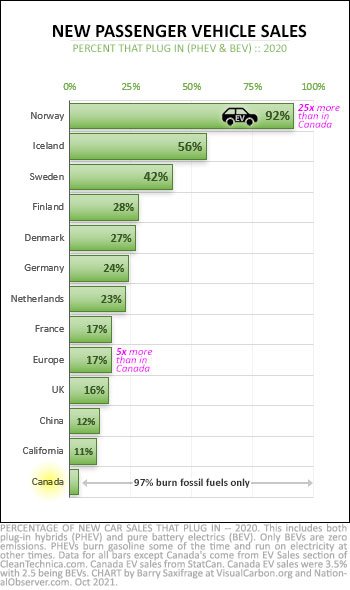
Only three percent of the new passenger cars Canadians bought last year can run on our super clean electricity.
Instead, we continue to fill our roads and driveways almost exclusively with new fossil burners. They will continue to burn like a storm and block the Canadian climate fault well beyond 2030.
It does not have to be this way.
Canada could have matched what our northern oil producer pair, Norway, did.
Years ago, Norway enacted a set of policies to favor electric vehicles that are safer for the climate. Today, Norwegians choose electric vehicles for more than 90 percent of their new passenger vehicle sales. Its fleet is becoming so electrified that pump sales have been declining in Norway for several years in a row.
We could do that now.
Canada could also have matched what the British did in the 1990s to control transport emissions. They raised their gasoline taxes by the equivalent of $ 290 per tCO2 in just eight years.
We could do that now.
We have many examples of proven and effective climate policies that we could adopt. We are simply not acting.
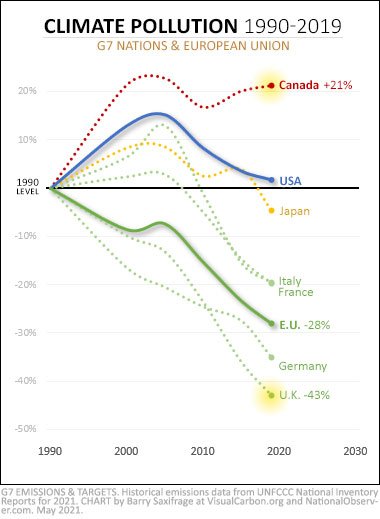
Canada first promised to reduce our oversized climate pollution back in 1988. As my final graph sadly shows, we have not done so. Instead, we have the worst climate record among our G7 peers. With much.
Is this really what we want to be?
If not, then we need to start reducing the burning of fossil fuels and “electrify everything” instead. And that’s especially true for our most polluting and least electrified sector: transportation.
What would that look like?
First of all, it means not buying more fossil-burning vehicles. Every time a new fossil burner comes out, all future climate pollution is trapped. And the opportunity to switch to electricity that is safer for the Canadian manufacturing climate is lost for another decade or two, until that vehicle is scrapped.
And a second big climate step that many Canadians can take with their transportation dollars is to stop burning fossil jet fuel. That’s our second largest cause of transportation emissions and our fastest growing since 2005. So when you fly, be sure to opt for a zero-emissions flight. Choose one that runs on electricity or green hydrogen.
The aviation industry has been talking about its commitment to providing clean and climate-safe flights for decades. So there are surely plenty of great weather-safe flight options to choose from by now. And if for some reason you can’t find one, then you can always do what I and a growing number of climate-conscious people are doing: stay grounded until Big Air offers more than a bright green wash coat over its mounting damage. climatic
The bottom line is that government data has made it painfully clear that our burning of fossil fuels continues to increase dangerously in Canada. And that’s especially true when it comes to moving ourselves and our things. If we want to have the opportunity to fight for a healthy and safe future, we have to start acting as if it were a crisis, stop our burning and get down to work electrifying everything we do.
——————–
Next Up: This was Part 2 of a three-part series on “Electrifying Everything” in Canada. The final article will look at one of the most electrified sectors in Canada: residential buildings.
Reference-www.nationalobserver.com